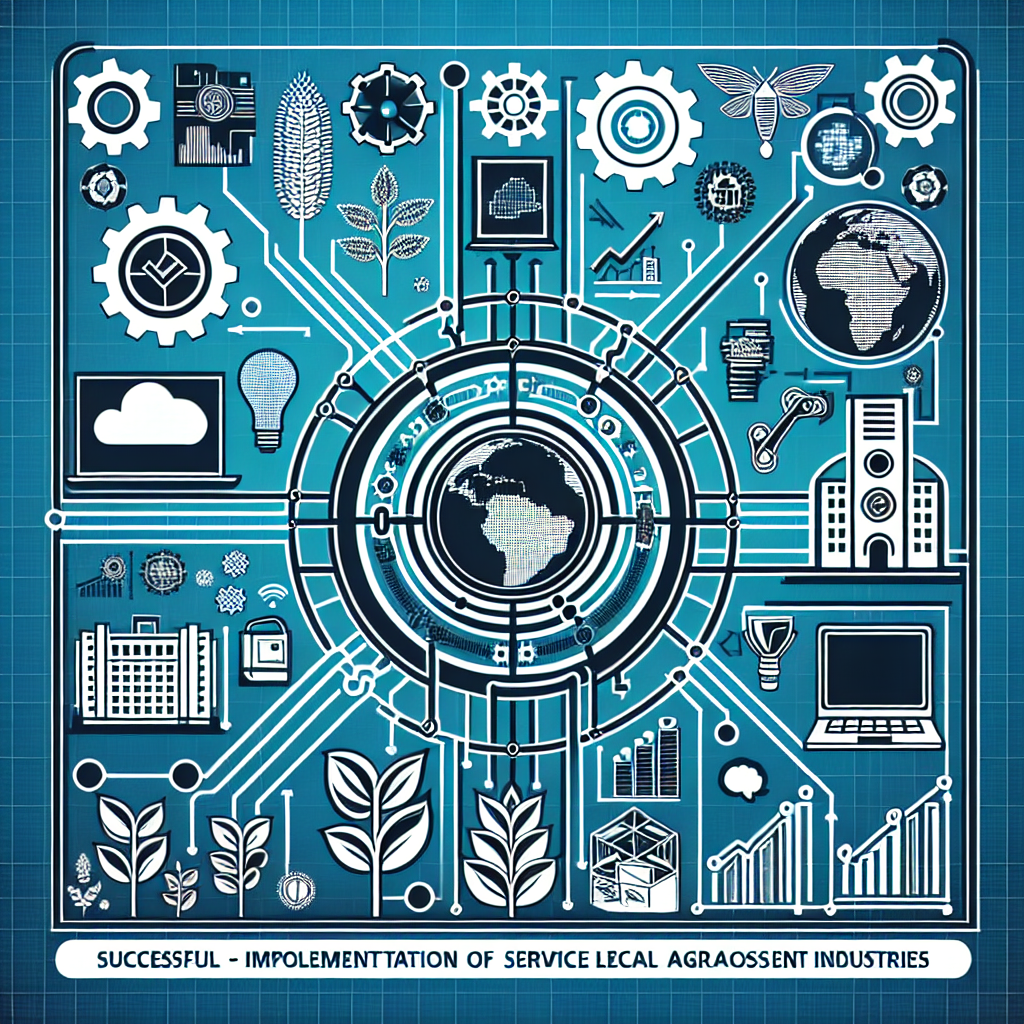Your cart is currently empty!
Tag: Agreements

The Future of Service Level Agreements (SLAs) in the Digital Age
Service Level Agreements (SLAs) have long been a standard practice in the world of business, outlining the expectations and responsibilities between a service provider and their clients. However, as we continue to move further into the digital age, the future of SLAs is evolving to meet the demands of a rapidly changing landscape.In the past, SLAs were typically focused on delivering a specific level of service, such as uptime or response time. While these metrics are still important, the digital age has brought about new challenges and opportunities that require a more dynamic approach to SLAs.
One of the key trends shaping the future of SLAs is the increasing reliance on cloud services and digital technologies. With more and more businesses moving their operations to the cloud, the traditional SLA model may no longer be sufficient to ensure the smooth functioning of these services. As a result, SLAs are now being adapted to include provisions for data security, compliance, and scalability to meet the unique needs of digital businesses.
Another important factor driving the evolution of SLAs is the rise of artificial intelligence (AI) and automation. As AI becomes more prevalent in business operations, SLAs will need to be updated to account for the potential impact on service delivery. This may include provisions for monitoring and managing AI systems, as well as ensuring that they are operating within ethical and legal boundaries.
Furthermore, the increasing interconnectedness of digital services means that SLAs will need to be more flexible and adaptable to account for the complex relationships between different service providers. This may involve the use of multi-level SLAs that outline the responsibilities of each party involved in delivering a service, as well as mechanisms for resolving disputes and managing performance issues.
Overall, the future of SLAs in the digital age is likely to be characterized by greater flexibility, transparency, and collaboration between service providers and their clients. As businesses continue to embrace digital technologies and adopt new ways of working, SLAs will need to evolve to meet the changing needs of the modern business landscape. By staying ahead of these trends and adapting their SLAs accordingly, businesses can ensure that they are able to deliver the high-quality services that their clients expect in the digital age.

Best Practices for Drafting and Managing Service Level Agreements (SLAs)
A Service Level Agreement (SLA) is a contractual agreement between a service provider and their customer that outlines the level of service that will be provided. SLAs are essential for ensuring that both parties have a clear understanding of expectations and responsibilities.When drafting and managing SLAs, it is important to follow best practices to ensure that the agreement is effective and meets the needs of both parties. Here are some best practices for drafting and managing SLAs:
1. Define clear and measurable metrics: When drafting an SLA, it is important to define clear and measurable metrics that will be used to track the performance of the service provider. These metrics should be specific, relevant, achievable, and time-bound. By clearly defining these metrics, both parties will have a clear understanding of what is expected.
2. Include performance targets: In addition to defining metrics, it is important to include performance targets in the SLA. These targets should outline the level of service that is expected from the service provider. By including performance targets, both parties will have a clear understanding of what is expected and can work towards achieving these targets.
3. Include remedies for non-performance: It is important to include remedies for non-performance in the SLA. These remedies should outline what steps will be taken if the service provider fails to meet the agreed-upon performance targets. By including remedies for non-performance, both parties will have a clear understanding of the consequences of failing to meet the agreed-upon performance targets.
4. Regularly review and update the SLA: SLAs should be regularly reviewed and updated to ensure that they continue to meet the needs of both parties. By regularly reviewing and updating the SLA, both parties can ensure that the agreement remains relevant and effective.
5. Communication is key: Communication is key when managing SLAs. Both parties should communicate regularly to ensure that the agreement is being followed and that any issues are addressed promptly. By maintaining open and transparent communication, both parties can work together to ensure that the SLA is effective.
In conclusion, drafting and managing SLAs requires careful planning and attention to detail. By following best practices such as defining clear and measurable metrics, including performance targets, including remedies for non-performance, regularly reviewing and updating the SLA, and maintaining open communication, both parties can ensure that the agreement is effective and meets their needs.

Leveraging Service Level Agreements (SLAs) to Drive Business Performance
Service Level Agreements (SLAs) are a critical component of any business relationship, providing a clear outline of the services to be provided and the expected level of performance. By leveraging SLAs effectively, businesses can drive improved business performance, enhance customer satisfaction, and ultimately achieve their strategic objectives.One of the key benefits of SLAs is the establishment of clear expectations between service providers and their customers. By clearly outlining the scope of services, performance metrics, and responsibilities of both parties, SLAs help to prevent misunderstandings and ensure that both parties are aligned on goals and expectations. This clarity can help to avoid disputes and conflicts, leading to smoother and more productive business relationships.
In addition to setting clear expectations, SLAs also provide a framework for measuring performance and holding service providers accountable. By establishing key performance indicators (KPIs) and defining acceptable levels of performance, businesses can track and monitor the performance of their service providers, identify areas for improvement, and take corrective actions when necessary. This level of transparency and accountability can help to drive continuous improvement and ensure that service providers are meeting their obligations.
Furthermore, SLAs can be used as a tool for driving business performance by incentivizing service providers to exceed expectations and deliver exceptional service. By including performance incentives and penalties in SLAs, businesses can motivate service providers to go above and beyond to meet or exceed performance targets. This can help to drive a culture of excellence and encourage service providers to continuously strive for improvement.
Another way in which businesses can leverage SLAs to drive business performance is by using them as a basis for continuous feedback and improvement. By regularly reviewing SLA performance metrics and conducting post-mortem reviews of service delivery, businesses can identify areas for improvement, implement corrective actions, and drive continuous improvement in service delivery. This ongoing feedback loop can help to ensure that service providers are meeting their obligations and delivering value to the business.
In conclusion, leveraging SLAs effectively can help businesses drive improved business performance, enhance customer satisfaction, and achieve their strategic objectives. By establishing clear expectations, measuring performance, incentivizing excellence, and using SLAs as a tool for continuous improvement, businesses can ensure that their service providers are meeting their obligations and delivering exceptional service. By using SLAs as a strategic tool, businesses can drive performance, enhance customer satisfaction, and achieve their business goals.

The Role of Service Level Agreements (SLAs) in Ensuring Customer Satisfaction
Service Level Agreements (SLAs) play a crucial role in ensuring customer satisfaction in today’s competitive business environment. An SLA is a contractual agreement between a service provider and a customer that outlines the level of service that the provider will deliver. These agreements are essential in establishing clear expectations and performance metrics for both parties, ultimately leading to improved customer satisfaction.One of the key benefits of SLAs is that they provide a clear understanding of the services that will be provided and the responsibilities of both the service provider and the customer. By clearly defining the scope of services, response times, and performance metrics, SLAs help to eliminate misunderstandings and ensure that both parties are on the same page. This transparency fosters trust and accountability, which are essential for building strong, long-lasting relationships with customers.
SLAs also help to set performance standards and hold service providers accountable for meeting those standards. By specifying key performance indicators (KPIs) such as response times, uptime, and resolution times, SLAs provide a benchmark for measuring the quality of service. This not only helps to identify areas for improvement but also ensures that customers receive the level of service they expect and deserve.
In addition, SLAs help to prioritize service delivery based on the needs and preferences of the customer. By outlining service levels for different types of issues or requests, SLAs ensure that critical issues are addressed promptly and efficiently, while less urgent issues are handled in a timely manner. This helps to streamline the service delivery process and ensure that customers receive the level of service that they require.
Furthermore, SLAs can also help to improve communication between service providers and customers. By establishing clear channels of communication and escalation procedures, SLAs ensure that issues are addressed promptly and effectively. This not only helps to resolve problems quickly but also demonstrates to customers that their concerns are being taken seriously.
Overall, the role of SLAs in ensuring customer satisfaction cannot be overstated. By establishing clear expectations, setting performance standards, prioritizing service delivery, and improving communication, SLAs help to build trust, accountability, and strong relationships with customers. In today’s competitive business environment, having strong SLAs in place is essential for delivering high-quality service and ultimately driving customer satisfaction.

The Benefits of Establishing Service Level Agreements (SLAs) with Vendors
Service Level Agreements (SLAs) are essential tools in business relationships, especially when it comes to working with vendors. An SLA is a contract between a service provider and a customer that outlines the level of service that will be provided, as well as the metrics that will be used to measure that service. Establishing SLAs with vendors can bring a number of benefits to your business.One of the key benefits of establishing SLAs with vendors is that it helps to ensure that both parties are on the same page when it comes to expectations. By clearly outlining what services will be provided, as well as the quality and timeliness of those services, both the vendor and the customer can avoid misunderstandings and disputes down the line. This can help to build trust and strengthen the relationship between the two parties.
Another benefit of SLAs is that they provide a framework for measuring the vendor’s performance. By specifying metrics such as response times, resolution times, and uptime guarantees, both parties can track the vendor’s performance and hold them accountable for meeting their commitments. This can help to ensure that the vendor is delivering the level of service that was promised, and can provide a basis for discussing any issues or concerns that arise.
Establishing SLAs can also help to improve the overall quality of the services that are being provided. By setting clear expectations and standards for performance, vendors are motivated to deliver high-quality service in order to meet or exceed those standards. This can lead to improved efficiency, productivity, and customer satisfaction, as well as a reduction in errors and delays.
In addition, SLAs can help to streamline communication and problem resolution between the vendor and the customer. By clearly defining the processes for reporting and resolving issues, both parties can work together more effectively to address any problems that arise. This can help to minimize downtime, reduce disruptions to business operations, and ultimately improve the overall customer experience.
Overall, establishing SLAs with vendors can bring a number of benefits to your business, including improved communication, better performance tracking, and higher-quality service delivery. By setting clear expectations and standards for performance, both parties can work together more effectively to achieve their goals and build a strong and successful business relationship.

The Future of Service Level Agreements: Trends and Innovations.
Service Level Agreements (SLAs) have long been a cornerstone of the relationship between service providers and their clients. These formal agreements outline the level of service that can be expected, including metrics such as response times, uptime guarantees, and resolution times.However, as technology continues to evolve at a rapid pace, the future of SLAs is also changing. In the past, SLAs were often seen as static documents that were negotiated at the beginning of a contract and then rarely revisited. But as businesses become increasingly reliant on technology to deliver their services, the need for more dynamic and flexible SLAs is becoming apparent.
One trend that is emerging in the world of SLAs is the use of automated monitoring and reporting tools. These tools allow service providers to track key performance indicators in real-time, providing both parties with up-to-date information on the level of service being delivered. This not only ensures greater transparency but also allows for more proactive management of service levels.
Another trend is the use of artificial intelligence and machine learning to predict and prevent service disruptions before they occur. By analyzing historical data and patterns, AI can identify potential issues and take corrective action before they impact service levels. This proactive approach can help to minimize downtime and ensure a more consistent level of service.
Innovations in cloud computing are also driving changes in SLAs. With more and more businesses moving their services to the cloud, the traditional model of SLAs based on physical infrastructure is becoming outdated. Instead, SLAs are now focusing on the performance and availability of cloud services, as well as the security and compliance of data stored in the cloud.
One of the key challenges facing the future of SLAs is the increasing complexity of technology ecosystems. With the rise of hybrid and multi-cloud environments, as well as the proliferation of connected devices and IoT, service providers are being asked to deliver services across a more diverse and interconnected landscape. This requires a more holistic approach to SLAs, taking into account not just individual components but the entire ecosystem in which services operate.
Overall, the future of SLAs is one of greater agility, transparency, and proactivity. By leveraging new technologies and approaches, service providers can deliver more reliable and responsive services, while clients can have greater confidence in the level of service they are receiving. As businesses continue to rely on technology to drive their operations, the importance of SLAs as a tool for managing and measuring service levels will only continue to grow.

How to Enforce Service Level Agreements and Hold Providers Accountable
Service Level Agreements (SLAs) are essential in ensuring that service providers deliver the level of service that is expected by their clients. However, simply having SLAs in place is not enough. It is equally important to enforce these agreements and hold providers accountable for any breaches. Here are some tips on how to effectively enforce SLAs and ensure that service providers meet their obligations:1. Clearly define SLA metrics and expectations: The first step in enforcing SLAs is to clearly define the metrics and expectations that are outlined in the agreement. This includes specifying the level of service that is expected, as well as the consequences for failing to meet these targets. By clearly defining these expectations, both parties have a clear understanding of what is required.
2. Monitor performance: Monitoring the performance of service providers is crucial in enforcing SLAs. This can be done through regular performance reviews, monitoring of key performance indicators (KPIs), and conducting regular audits to ensure that the provider is meeting the agreed-upon standards. By monitoring performance, you can quickly identify any issues and address them before they become larger problems.
3. Communicate regularly: Communication is key in enforcing SLAs. Regularly communicate with service providers to provide feedback on their performance and to discuss any concerns or issues that may arise. By maintaining open lines of communication, you can address any issues quickly and ensure that the provider is meeting their obligations.
4. Implement penalties for non-compliance: SLAs should include penalties for non-compliance to ensure that service providers are held accountable for their performance. These penalties could include financial penalties, termination of the agreement, or other consequences as outlined in the SLA. By implementing penalties for non-compliance, service providers are incentivized to meet their obligations and deliver the level of service that is expected.
5. Review and revise SLAs as needed: SLAs should be regularly reviewed and revised as needed to ensure that they continue to meet the needs of both parties. As business requirements and technologies evolve, SLAs may need to be updated to reflect these changes. By reviewing and revising SLAs as needed, you can ensure that the agreement remains relevant and continues to effectively enforce the expectations of both parties.
In conclusion, enforcing SLAs and holding service providers accountable is essential in ensuring that they deliver the level of service that is expected. By clearly defining expectations, monitoring performance, communicating regularly, implementing penalties for non-compliance, and reviewing and revising SLAs as needed, you can effectively enforce SLAs and ensure that service providers meet their obligations.
How to Create Effective Service Level Agreements for Your Company
Service Level Agreements (SLAs) are essential documents that outline the expectations and responsibilities between a service provider and a client. They ensure that both parties are on the same page regarding the level of service that will be provided and help to prevent misunderstandings or disputes in the future. Creating effective SLAs for your company is crucial for maintaining good relationships with clients and delivering high-quality service. Here are some tips on how to create effective SLAs for your company:1. Understand the needs and expectations of your clients: Before drafting an SLA, it is important to have a clear understanding of your clients’ needs and expectations. This will help you tailor the SLA to meet their specific requirements and ensure that you are able to deliver on your promises.
2. Define the scope of services: Clearly outline the scope of services that will be provided, including the specific tasks and responsibilities that are included in the agreement. This will help to prevent any misunderstandings about what is and is not covered under the SLA.
3. Set measurable performance metrics: Include specific performance metrics in the SLA that can be easily measured and monitored. This could include things like response times, resolution times, and uptime guarantees. Setting measurable metrics will help to ensure that both parties are able to track and evaluate the level of service being provided.
4. Establish consequences for non-compliance: It is important to include consequences for non-compliance with the SLA, such as penalties or termination of the agreement. This will help to incentivize both parties to meet their obligations and ensure that the SLA is taken seriously.
5. Include a process for resolving disputes: It is important to include a process for resolving disputes in the SLA, including how issues will be escalated and resolved. This will help to ensure that any conflicts are addressed in a timely and efficient manner, minimizing the impact on the client.
6. Review and update regularly: SLAs should be reviewed and updated regularly to ensure that they continue to meet the needs of both parties. As the business environment and client requirements evolve, it is important to make any necessary adjustments to the SLA to reflect these changes.
In conclusion, creating effective SLAs for your company is essential for maintaining good relationships with clients and delivering high-quality service. By understanding the needs and expectations of your clients, defining the scope of services, setting measurable performance metrics, establishing consequences for non-compliance, including a process for resolving disputes, and regularly reviewing and updating the SLA, you can ensure that your company is able to meet its obligations and provide excellent service to clients.

The Importance of Service Level Agreements (SLAs) in Business
Service Level Agreements (SLAs) are crucial for businesses as they define the level of service expected from a service provider. These agreements outline the responsibilities of both parties and ensure that expectations are clearly communicated and met. Here are some key reasons why SLAs are important in business:1. Defines Expectations: SLAs clearly outline the services to be provided, the metrics by which they will be measured, and the responsibilities of both parties. This helps to prevent misunderstandings and ensures that both parties are on the same page regarding the level of service expected.
2. Ensures Accountability: SLAs hold service providers accountable for meeting the agreed-upon performance standards. If the service provider fails to meet the agreed-upon service levels, the SLA provides a basis for recourse, such as penalties or termination of the agreement.
3. Improves Communication: SLAs facilitate open communication between the service provider and the customer. By clearly defining expectations and responsibilities, SLAs help to avoid miscommunication and ensure that both parties are aligned on the goals and objectives of the service.
4. Drives Performance: SLAs provide a framework for measuring and monitoring the performance of the service provider. By setting specific performance metrics and targets, SLAs motivate service providers to continuously improve their performance and deliver high-quality service.
5. Enhances Customer Satisfaction: SLAs help to ensure that customers receive the level of service they expect. By setting clear expectations and holding service providers accountable for meeting those expectations, SLAs help to build trust and confidence with customers, leading to higher levels of satisfaction and loyalty.
6. Mitigates Risks: SLAs help to mitigate risks by establishing clear guidelines for service delivery and performance. By outlining the consequences of failing to meet the agreed-upon service levels, SLAs help to protect both parties from potential disputes and financial losses.
In conclusion, Service Level Agreements are essential in business as they define expectations, ensure accountability, improve communication, drive performance, enhance customer satisfaction, and mitigate risks. By establishing clear guidelines for service delivery and performance, SLAs help to build strong and successful partnerships between service providers and customers. Businesses that prioritize SLAs are more likely to deliver high-quality service, meet customer expectations, and achieve long-term success.

Case Studies: Successful Implementation of Service Level Agreements in Various Industries
Service Level Agreements (SLAs) are a crucial component of any business relationship, outlining the expectations and responsibilities of both parties involved. By clearly defining the services to be provided, the quality standards to be met, and the consequences for failing to meet those standards, SLAs help ensure that both parties are on the same page and working towards the same goals.In various industries, successful implementation of SLAs has led to improved customer satisfaction, increased efficiency, and stronger partnerships between service providers and their clients. Let’s take a look at some case studies that highlight the successful implementation of SLAs in different industries:
1. IT Services Industry:
A leading IT services company implemented SLAs with their clients to outline the response times for resolving technical issues, the uptime guarantees for their systems, and the penalties for any service disruptions. By clearly defining these expectations upfront, the company was able to improve the efficiency of their operations, reduce downtime, and increase customer satisfaction. As a result, their client retention rates improved, and they were able to expand their customer base through positive referrals.
2. Healthcare Industry:
A large hospital system implemented SLAs with their vendors to ensure timely delivery of medical supplies, maintenance of critical equipment, and compliance with regulatory requirements. By setting clear expectations and holding vendors accountable for meeting those expectations, the hospital system was able to streamline their procurement processes, reduce costs, and improve patient care outcomes. The SLAs also helped foster a strong partnership between the hospital system and their vendors, leading to better communication and collaboration.
3. Financial Services Industry:
A major financial institution implemented SLAs with their third-party service providers to ensure the security and confidentiality of customer data, compliance with industry regulations, and timely resolution of any issues. By establishing these SLAs, the financial institution was able to mitigate risks, protect their customers’ sensitive information, and maintain a high level of trust with their clients. The SLAs also helped the institution demonstrate their commitment to compliance and security to regulators and investors.
In conclusion, the successful implementation of SLAs in various industries has proven to be a valuable tool for improving efficiency, managing risks, and enhancing customer satisfaction. By setting clear expectations, measuring performance against those expectations, and holding parties accountable for meeting their obligations, businesses can build stronger partnerships, drive operational excellence, and achieve their strategic goals. Whether in IT services, healthcare, financial services, or any other industry, SLAs play a critical role in ensuring the success of business relationships.
